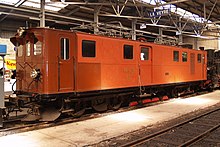BB Ge 6/6 81
| Ge 4/4 | |
|---|---|
|
BB Ge 6/6 81, from 1929 Ge 4/4
|
|
| Numbering: | BB 81 / RhB 81 / RhB 181 |
| Number: | 1 |
| Manufacturer: | SLM / BBC |
| Year of construction (s): | 1916 |
| Retirement: | 1970 (now museum vehicle) |
| Axis formula : | B'B ', originally C'C' |
| Genre : | 4th |
| Gauge : | 1000 mm ( meter gauge ) |
| Length over buffers: | 13,900 mm |
| Total wheelbase: | 9,800 mm |
| Service mass: | 46.6 t |
| Top speed: | 45 km / h, initially 50 km / h |
| Hourly output : | (1040 PS) |
| Continuous output : | 455 kW (620 PS) / after conversion: 705 kW (960 PS) |
| Starting tractive effort: | 14,500 kg |
| Driving wheel diameter: | 855 mm |
| Impeller diameter: | 280 mm (brake frame) |
| Power system : | 1000 V |
| Power transmission: | 2 pantographs |
| Number of traction motors: | 4th |
| Drive: | electric |
| Brake: | Vacuum brake, electrical resistance brake |
| Particularities: | 1929 Conversion from the Ge 6/6 to the Ge 4/4 |
The Ge 6/6 81 was a six-axis electric locomotive former Berninabahn ( BB ), which in the 1943 Rhätischen path opened (RhB). It was produced as a single piece by the Swiss Locomotive Factory in Winterthur with electrical equipment from Brown, Boveri & Cie. manufactured and delivered in 1916. As a narrow-gauge electric locomotive with six powered axles, it was given the type designation Ge 6/6 and road number 81. The locomotive has a small luggage compartment , but this is not reflected in the type designation, as the railway wanted to classify the vehicle as a locomotive and not as a multiple unit.
history
The rapid increase in traffic at the time made it necessary to have its own locomotive for heavy traffic. With a weight of 45 tons, originally distributed over six drive axles and two small axles for the subframe of the brake frame with the electromagnetic rail brake, and four traction motors, it was then considered the most powerful meter-gauge locomotive in Europe. Two motors each were firmly screwed into a bogie frame, and the power was initially transmitted from the motor shaft to a countershaft. The two countershafts and the central drive axle of each bogie were connected with a triangular frame. The outer axles were driven by coupling rods. This arrangement did not work. It is said that a triangular coupling rod was thrown through the roof at full speed after the cranks broke.
Conversion to the Ge 4/4 81
In 1929 the locomotive was converted from the C'C 'wheel arrangement to the B'B' wheel arrangement. The conversion was intended to increase the performance of the locomotive for planned express trains. The middle axle of each bogie was replaced by a jackshaft. The power transmission from the engines is now carried out by a gearbox. The drive axles are driven by slotted coupling rods. During the conversion, the locomotive was prepared for the upcoming voltage increase from 750 volts to 1000 volts. As a result, the output could be increased from 960 hp to 1040 hp. The maximum permissible speed has been reduced from 50 km / h to 45 km / h.
As a special feature, the locomotive has a subframe equipped with two axles for the electromagnetic rail brake fed from the contact line. As a result of this subframe, the locomotive would correctly have the wheel arrangement B'2'B ', originally C'2'C'. The type designation including the brake frame would be Ge 4/6 (or earlier Ge 6/8), taking into account the luggage compartment De 4/6 (formerly Fe 4/6 or Fe 6/8).
The locomotive was given the road number 181 on the Rhaetian Railway in 1961. In 1970 it was retired and came to the Blonay – Chamby (BC) museum railway , where it was initially used regularly. From 1990 onwards, damage to the electrical equipment prevented further use. It was not until 2008 that the locomotive could be refurbished with the help of a sponsor to such an extent that it has since been used again.
literature
- Claude Jeanmaire: The electric and diesel traction vehicles of Swiss railways. Fourth part: The direct current lines of the Rhaetian Railway. Archive No. 20, Verlag Eisenbahn, Villigen AG 1975, ISBN 3-85649-020-5 .
- Peter Willen: Locomotives of Switzerland 2, narrow-gauge traction units. Orell Füssli Verlag, Zurich 1972, without ISBN.
- Wolfgang Finke, Hans Schweers: The vehicles of the Rhaetian Railway: Locomotives, railcars, tractors . In: Wolfgang Finke (Ed.): The vehicles of the Rhaetian Railway, 1889–1996 . tape 3 . Schweers + Wall, Aachen 1998, ISBN 3-89494-105-7 (223 pages, [ limited preview in the Google book search]).


